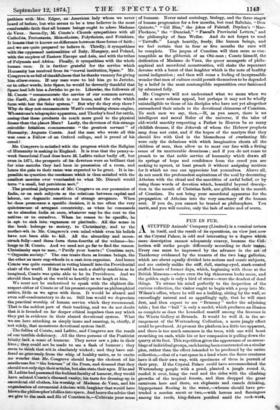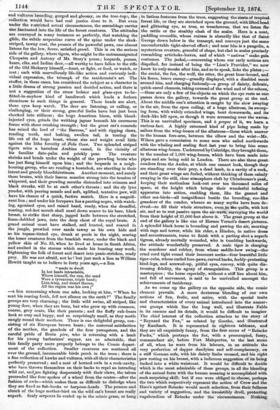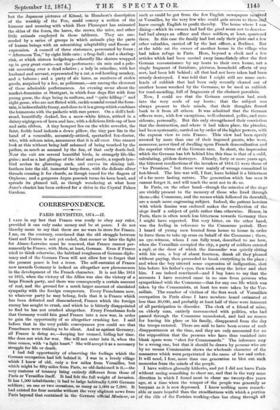FUN IN FUR.
A, STUFFED Animals' Company (Limited) is a comical notion in itself, and the result of its operations, on view just now at the Crystal Palace, is odd and interesting to a degree which mere description cannot adequately convey, because the Col- lection will strike people differently according to their tastes Every one must be impressed by the advance in the art of Taxidermy evidenced by the tenants of the two long galleries, which are about equally divided into serious and comic subjects, and are entirely unlike the stiff, dull, staring-eyed, stark-coated stuffed beasts of former days, which, beginning with those at the British Museum—where even the big rhinoceros looks mean, and the golden eagle is only a bird of straw—were the deadest of dead things. To attune his mind perfectly to the inspection of the curious collection, the visitor ought to begin with a peep into Mr. Wilson's office, where he will see a bulldog, sitting by the wall, so exceedingly natural and so appallingly ugly, that he will start first, and then expect to see " Brummy " under the adjoining table ; but the " bull " is only a model, which produces an illusion as complete as does the kennelled mastiff among the frescoes in the Wiertz Gallery at Brussels. It would be well if, in the ar- rangement of the Wurtemberg Collection, a more kingly effect could be produced. At present the platform is a little too apparent, and there is too much sameness in the frees, with one wild beast crouching on each, while his or her companion is pulling down the quarry at its foot. This repetition gives the appearance of an assem- blage of individual groups, each having been constructed ens similar plan, rather than the effect intended to be produced by the entire collection,—that of a vast space in a land where the fierce creatures have it all their own way, with specimens of them in pursuit of their prey. If the Crystal Palace could have accommodated the Wurtemberg people with a pond, planted a jungle round it, roofed it over, hung the roof and the sides with the climbing growths of the tropical forests, and then dropped the great carnivora here and there, set elephants and camels drinking, hippopotami floating in the water,—whence should have pro- truded a saurian snout or two,—with herons and flamingoes among the reeds, king-fishers perched amid the rock-work,
and vultures brooding, gorged and gloomy, on the tree-top, the collection would have had real justice done to it. But even under the r.mtricted actual circumstances, the assemblage carries one fascinated into the life of the forest creatures. The attitudes are conveyed in many instances so perfectly, that watching the glide, the subtle serpentine curve of the spine under the sleek- striped, tawny coat, the pounce of the powerful paws, one almost listens for the low, fierce, satisfied growl. This is on the serious side of the gallery, where tigers, who might be the untransmigrated Cleopatra and Antony of Mr. Story's poem ; leopards, pumas, bears, elks, and Indian deer,—all worthy to have fallen to the rifle of the Old Shekarry himself,—hunt, or fight, or feed, or watch, or rest ; each with marvellously life-like action and curiously indi- vidual expression, the triumph of the taxidermist's art. The stuffer, in these cases, has considered the subject as a character in a little drama of strong passion and decided action, and there is not a suggestion of the straw bolster and glass-eyes to-be- fitted-in-anyhow kind of handiwork which lends a forlorn dreariness to such things in general. These heads are alert, these eyes keep watch. The deer are listening, or calling, or challenging, or their strong, graceful limbs have but just been checked into stillness ; the huge American bison, with blood- injected eyes, grinds the writhing jaguar beneath his enormous frame with sheer crushing strength; but the great cat's comrade
has seized the lord of "the Barrens," and with ripping claws, rending teeth, and lashing, swollen tail, is tearing the life out of the huge beast, whose size and weight avail little against the lithe ferocity of Fells Oaca. Two splended striped tigers seize a harmless Arabian camel, in the vicinity of
his familiar date-palm and prickly pear. The creature shrinks and bends under the weight of the prowling brute who has just flung himself upon him ; and the leopards in a neigh- bouring group, who are rending a bontebok, are startling in their intent and greedy bloodthirstiness. Another moment, and surely these brutes, with their lissom muscles strung into the tension of whipcord, and their growling months distended into crimson and black streaks, will be at each other's throats ; and the sly lynx
yonder, with peering muzzle and soft, uplifted, tentative paw, will have his chance of a quick, furtive snatch. Here is a magnifi- cent lion ; and under his forepaws lies a panting neg,ro, with watch- ing, agonised eyes, and raised hand, ready, when the dreadful, roaring, red-hot mouth shall snarl down nearer to his bare, black breast, to strike that sharp, jagged knife between the stretched, foam-dabbled jaws, into the deep chest of the royal brute. A grand animal must have stalked, add hunted, and roared in the jungle, prowled over sands tawny as his own hide and as his topaze-tinted eye, drunk at pools in the night, scaring the lesser creatures from the brackish water, under the black and yellow skin of No. 35, when he lived at home in South Africa, and exulted in the storms which made his hunting easy work, frightening the folk of forest and desert into panic-stricken, ready
prey. He was not afraid, not he ! but just such a lion as William Hewitt taught us to believe in forty years ago,—a lion
"made to dwell In hot lands intractable, Where himself, the sun, the sand Were a tyrannous, triple band; Lion-king, and desert throne, All the region was his own ;"
—a lion concerning whom one asks, looking at him, "When he sent his roaring forth, fell not silence on the earth?" The family groups are very charming ; the little wild swine, all striped, like young deer, when they are born, but who grow up with common, coarse, grey coats, like their parents ; and the fluffy cub-bears look so cozy and happy, and so surprisingly small, as they nestle snugly round their mothers. There is one delightful group, con- siating of six European brown bears ; the maternal satisfaction of the mother, the gambols of the four youngsters, and the careful pride of Bruin pere, who is returning with a lamb for his young barbarians' supper, are so admirable, that this family party more properly belongs to the Comic depart- ment of the collection. Smaller creatures are scattered all over the ground, innumerable birds perch in the trees ; there is a fine collection of hawks and vultures, with all their characteristics perfectly preserved ; and a nest of horned owls in a rock-cavity, who have thrown themselves on their backs to repel an intruding wild cat, and:are fighting desperately with their claws, the talons protruded like four spokes of a wheel from the centre—after the fashion of owls—which makes them as difficult to dislodge when they are fixed as fish-hooks or harpoon-heads. The pounce and clutch of the huge mother-bird on the wild cat's breast are really superb. Scaly serpents lie curled up in the mimic grass, or hang in listless festoons from the trees, suggesting the siesta of tropical forest life, or they are stretched upon the ground, with lifted head and glittering eye, so true, so treacherous, that we listen for the rattle or the stealthy clash of the scales. Here is a neat, paddling crocodile, whose cuirass is absurdly like that of Saint George down below in the transept, and conveys just the same uncomfortable tight-sleeved effect ; and near him is a pangolin, a mysterious creature, graceful of shape, but clad in scales precisely resembling artichoke-leaves, and of which " natives " make gala costumes. The jackal,—concerning whom our early notions are dispelled, for instead of being the "Lion's Provider," we now know he only sneaks after him, and so to speak, licks the plates ;- the ocelot, the fox, the wolf, the otter, the great boar-hound, and his fierce, brave enemy—grandly displayed, with a disabled meute around him, and charging furiously—a group of dainty, delicate, quick-eared chamois, taking counsel of the wind and of the echoes, —these are only a few of the objects on which the eye rests as one passes down the gallery, towards the great group at the end. About the middle one's attention is caught by the slow swaying in the air, from the open ceiling, of a huge albatross, its swoop- ing form, with widely extended wings, bent downwards, and its duck-like bill open, as though it were screaming over the waves.. This is an unrivalled specimen, and a propos of it, we learn a. curious fact. A highly esteemed kind of pipe being made by sailors from the wing-bones of the albatross—those which answer to the human fore-arm, between the elbow and the wrist—Mr. Wilson gave a commission to some men who sailed northwards. with the whaling and sealing fleet last year to bring him some albatross wing-bones. Undeterred by Coleridge, they brought them,. to the number of 1,000 wing-bones, which have been made into, pipes and are being sold in London. There are also three great, condors from the Andes, at which one cannot look, though they are standing over their prey, a dead lamb, in a cavity of a rock, and their great wings are furled, without thinking of them calmly swaying in the still, clear atmosphere cleft by Chimborazo's peak., keeping their motionless look-out over ten thousand miles ot space, at the height which brings their wonderful inflating apparatus into action, enabling them, like the gannet and other sea-birds--all insignificant beside the brooding, roc-like grandeur of the condor, whence so many myths have been de- rived—to fill their whole structure, even,to the quills, with hot air, and so to rest passive upon the air-wave, surveying the world from their height of 21,000 feet above it. The great group at the end of the gallery is like one of Horace Vernet's desert pictures.. A splendid black horse is bounding and pawing the air, snorting with rage and terror, while his rider, a Iiindoo, in native dress and accoutrements, turns to finish with a parting shot a superb tigress, already mortally wounded, who is tumbling backwards, the attitude wonderfully preserved. A male tiger is charging the murderer and robber, from whose saddle-bow swing—the cruel cord tight round their innocent necks—four beautiful little tiger-cubs, whose curled fore-paws, curved backs, feebly-protesting hind-legs, and screwed-up, pitiful eyes, convey, with quite dis- tressing fidelity, the agony of strangulation. This group is a masterpiece ; the horse especially, without a stiff line about him, and full of movement, is said to be unrivalled amongst the achievements of taxidermy.
As we come up the gallery on the opposite side, the comic element prevails. A more dexterous blending of our own notions of fun, frolic, and satire, with the special traits and characteristics of every animal introduced into the numer- ous groups which line the long wall, and illustrate Fable in its essence and its details, it would be difficult to imagine The chief interest of the collection attaches to the story of " Reynard the Fox," as related by Goethe, and illustrated by Kaulbach. It is represented in eighteen tableaux, and they are all exquisitely funny, from the first scene of "Reineke Fuchs," which portrays the fox, with a preoccupied, fussy,. commandant air, before Fort Malepertus, to the last scene of all, when he rests from his labours, in an attitude the very perfection of dapper dandyism and self-complacency, on a stiff German sofa, with his dainty limbs crossed, and his right paw resting on his breast, with a ludicrous suggestion of its being tucked into a white waistcoat. It would be difficult to decide which is the most admirable of these groups, in all the blending of the animal form with the human meaning is accomplished with such surprising skill; but if one were obliged to choose, perhaps the two which respectively represent the action of Crow and the Hare's against Reineke would merit selection, from their fullness and variety of suggestion, and the irresistibly droll, protesting vagabondism of Reineke under the circumstances. Nothing but the Japanese pictures of Kitsne, in Humbert's description of the worship of the Fox, could convey a notion of the humour and meaning with which Herr Ploucquet has animated the skins of the foxes, the hares, the crows, the mice, and other little animals employed in these tableaux. They are suc- ceeded by a series of groups in which animals play the parts of human beings with an astonishing adaptability and finesse of expression. A council of three statesmen, personated by foxes ; "Afternoon Tea," by eight little cats ; a frog-ball; and a skating- rink, at which sixteen hedgehogs—absurdly like skaters wrapped up in grey great- coats—are the performers ; six cats and a pole- cat mourning over a dead relative ; a lady in crinoline, with her husband and servant, represented by a cat, a red howling monkey, and a baboon ; and a party of six hares, as receivers of stolen goods, surprised by a fox, as policeman,—are among the cleverest of these admirable performances. An evening scene about the market-fountains at Stuttgart, in which four dogs flirt with four young geese, the dogs being in uniform, and "quite killing ;" and eight geese, who are not flirted with, cackle scandal round the foun- tain, is indescribably funny, and close to it is a group which combines the humorous with the pathetic with rare power. On a doll's bed- stead, beautifully decked, lies a snow-white kitten, attired in a dainty nightgown of lawn and lace, with a delicious little cap of lace and satin ribbon. A tiny bouquet lies on the white coverlet, the faint, feeble head indents a down pillow, the tiny paw lies in the hand of a venerable, accurately-attired, spectaded fox-doctor, who, with solemn mien, announces that it is all over. One cannot look at this without being half ashamed of being touched by the pathos, as much as amused by the fun, of that early death-bed. Near the exit are several beautiful birds, in strangely life-like guise; and as a last glimpse of the ideal and poetic, a superb lyre- bird arches its glistening neck, and curves its shining tail- feathers into the old, immortal harp-form, with the delicate silver threads crossing it for chords, as though tuned for the fingers of Orpheus; and a gorgeous Argu, s peacock turns its keen head, and spreads its plumed tail, as though wondering at what hour Juno's chariot has been ordered for a drive in the Crystal Palace Gardens.
































 Previous page
Previous page